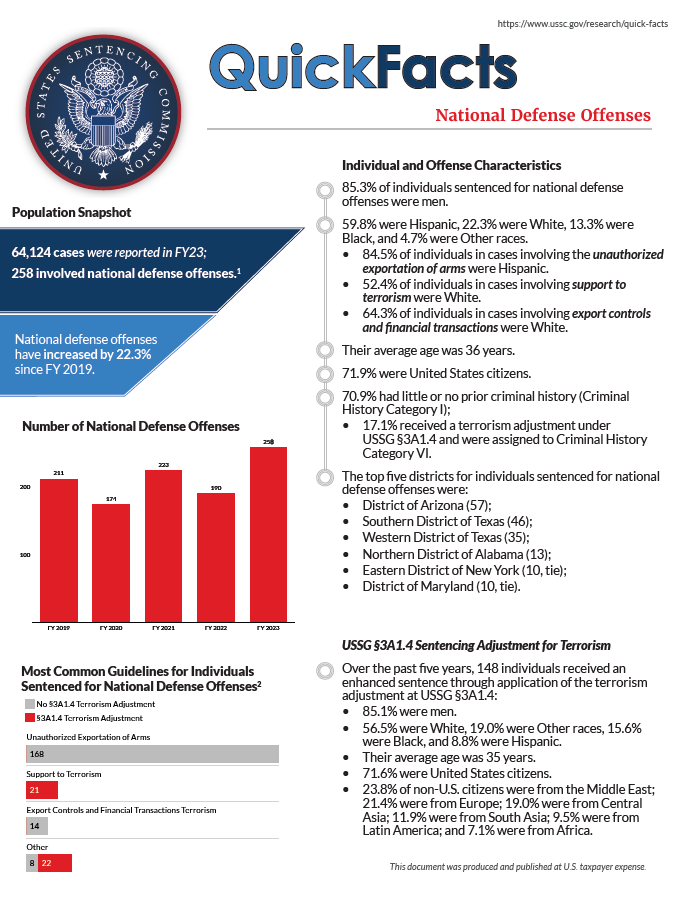Of the 61,678 cases reported to the Commission in fiscal year 2024, 255 involved national defense offenses. National defense offenses have increased by 46.6% since fiscal year 2020.1,2
Click the cover for the PDF handout or learn more below.
Individual and Offense Characteristics
- 87.0% of individuals sentenced for national defense offenses were men.
- 65.2% were Hispanic, 19.8% were White, 9.9% were Black, and 5.1% were Other races.
- 86.0% of individuals in cases involving the unauthorized exportation of arms were Hispanic.
- 42.9% of individuals in cases involving exports controls and financial transactions terrorism were White.
- 44.4% of individuals in cases involving support to terrorism were White and 44.4% were Black.
- Their average age was 38 years.
- 68.3% were United States citizens.
- 79.9% had little or no prior criminal history (Criminal History Category I);
- 15.0% received a terrorism adjustment under USSG §3A1.4, which requires that the defendant’s criminal history category be Category VI.
- 15.0% received a terrorism adjustment under USSG §3A1.4, which requires that the defendant’s criminal history category be Category VI.
- The top five districts for national defense offenses were:
- Southern District of Texas (66);
- District of Arizona (49);
- Western District of Texas (29);
- Northern District of Alabama (17);
- Southern District of Florida (12).
USSG §3A1.4 Sentencing Adjustment for Terrorism
- Over the past five years, 150 individuals received an enhanced sentence through application of the terrorism adjustment at USSG §3A1.4; of these:
- 85.3% were men;
- 54.3% were White, 19.5% were Black, 13.4% were Other races, and 12.8% were Hispanic;
- Their average age was 36 years;
- 72.0% were United States citizens;
- 23.8% of non-U.S. citizens were from the Latin America; 21.4% were from the Middle East; 19.0% were from Europe; 16.7% were from Central Asia; 9.5% were from Africa; and 7.1% were from South Asia.
Punishment
- 83.9% of individuals sentenced for national defense offenses were sentenced to prison.
- The average sentence was 53 months.
- The average sentence for individuals convicted of unauthorized exportation of arms was 24 months.
- The average sentence for individuals convicted of export controls and financial transactions terrorism was 16 months.
- The average sentence for individuals convicted of support to terrorism was 121 months.
- The average sentence for individuals who received a terrorism adjustment under USSG §3A1.4 was 228 months.
Sentences Relative to the Guideline Range
- 53.1% of sentences for national defense offenses were under the Guidelines Manual.
- 33.5% were within the guideline range.
- 11.8% were substantial assistance departures.
- The average sentence reduction was 54.5%.
- The average sentence reduction was 54.5%.
- 7.9% were some other downward departure.
- The average sentence reduction was 57.5%.
- The average sentence reduction was 57.5%.
- 33.5% were within the guideline range.
- 46.9% of sentences for national defense offenses were variances.
- 46.5% were downward variances.
- The average sentence reduction was 55.1%.
- The average sentence reduction was 55.1%.
- 0.4% were upward variances.3
- 46.5% were downward variances.
- The average guideline minimum fluctuated and the average sentence imposed increased over the past five years.
- The average guideline minimum increased and decreased throughout the fiscal years. The average guideline minimum was 70 months in fiscal year 2020 and 78 months in fiscal year 2024.
- The average sentence imposed increased from 44 months in fiscal year 2020 to 53 months in fiscal year 2024.
- The average guideline minimum increased and decreased throughout the fiscal years. The average guideline minimum was 70 months in fiscal year 2020 and 78 months in fiscal year 2024.
1 National defense cases include cases in which the individual was sentenced under USSG Chapter Two, Part M (Offenses Involving National Defense and Weapons of Mass Destruction) or under other guidelines which involve criminal conduct threatening to national defense. National defense cases also include cases in which the individual received a sentencing enhancement under USSG §3A1.4 (Terrorism).
2 Cases with incomplete sentencing information were excluded from the analysis.
3 The Commission does not report the average for categories with fewer than three cases.
SOURCE: United States Sentencing Commission, FY 2020 through FY 2024 Datafiles, USSCFY20-USSCFY24.

